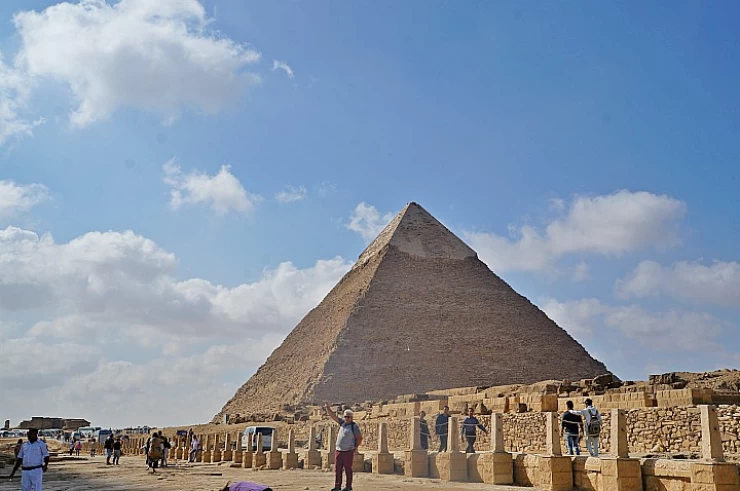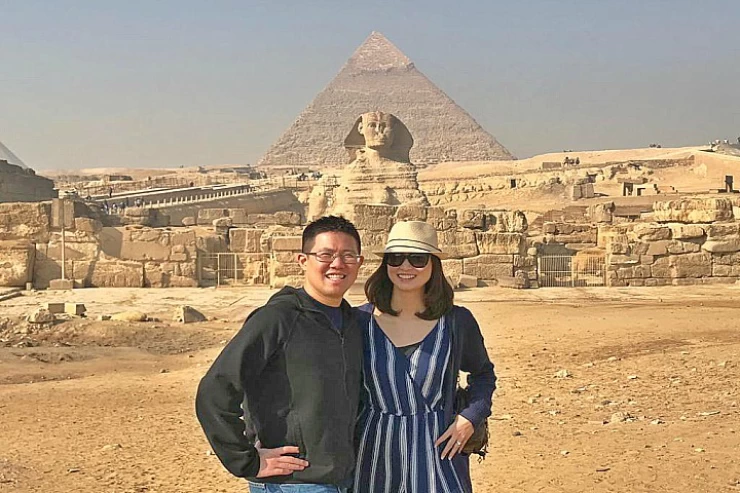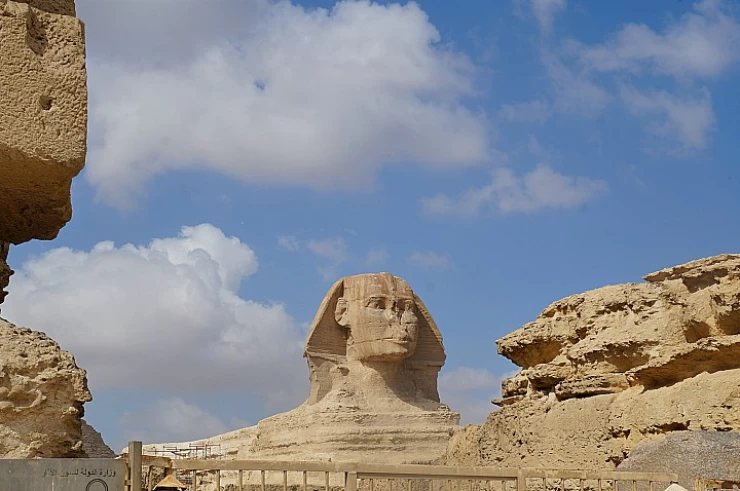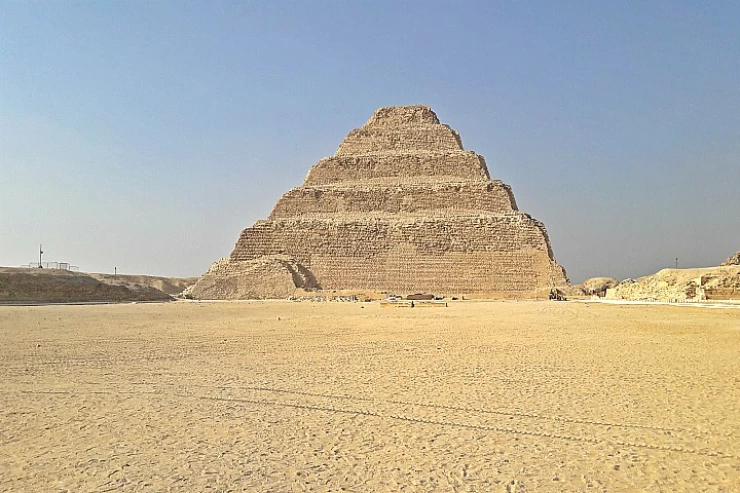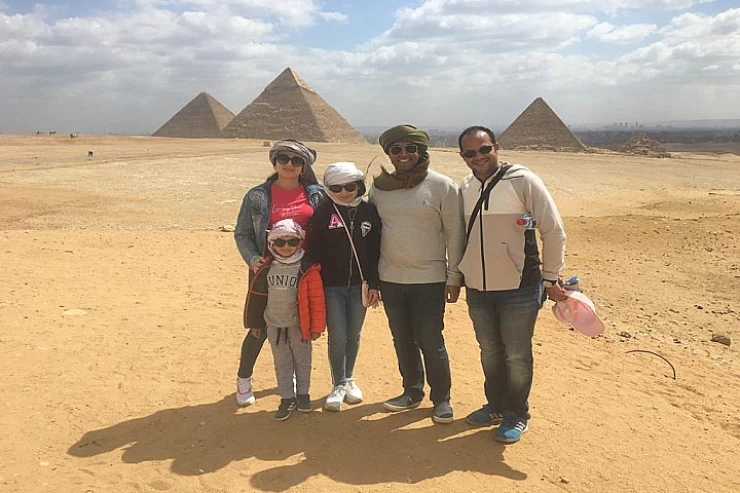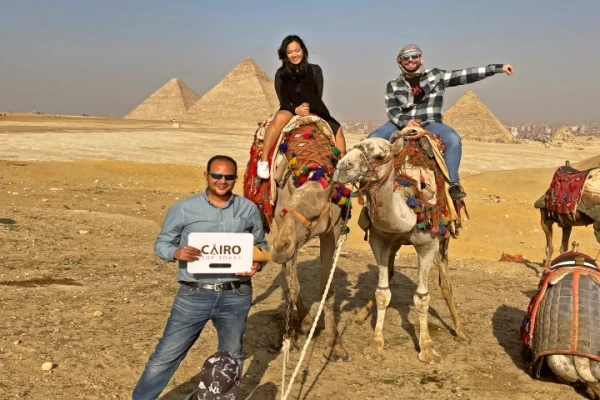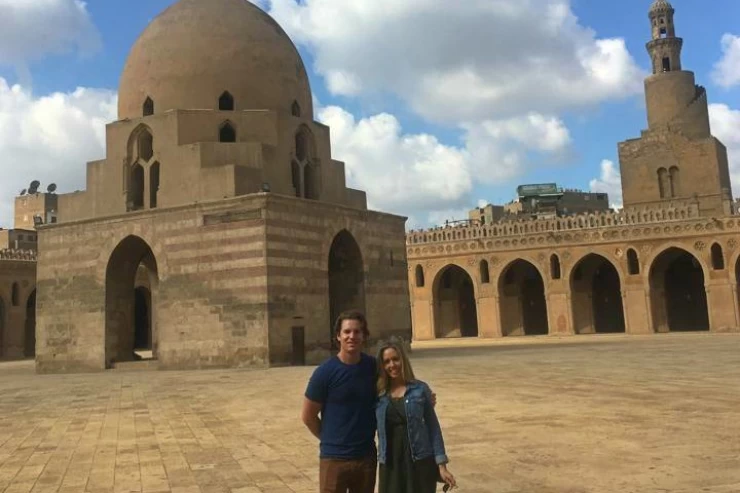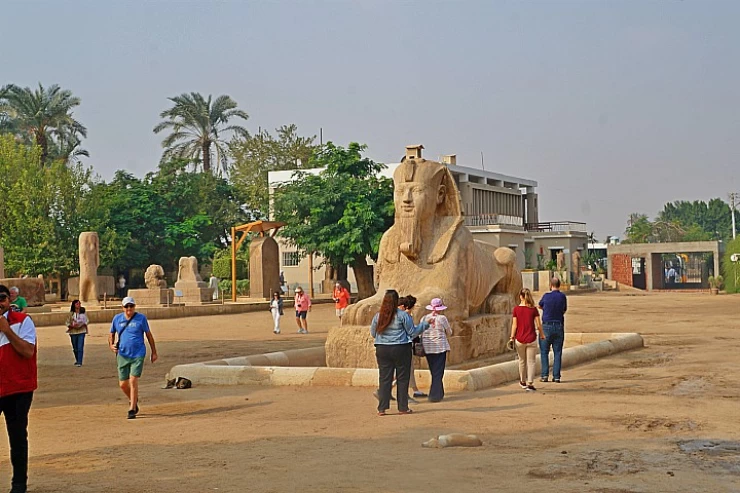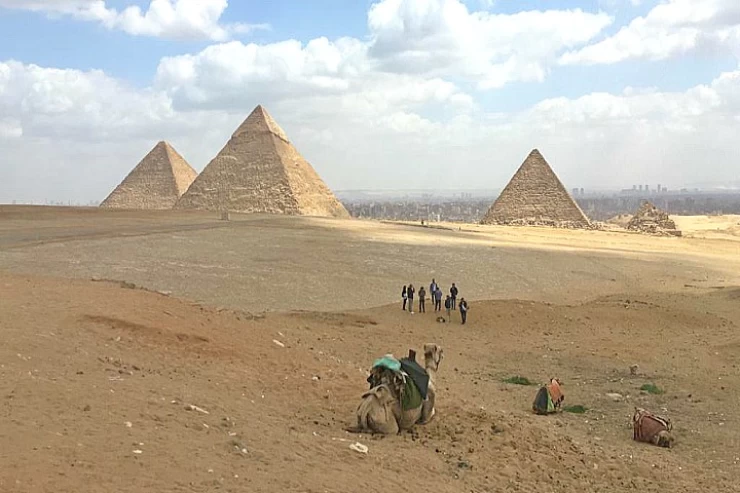Tour to Giza Pyramids and Saqqara Necropolis from Cairo
Overview
We excel in organizing one-day tours from Cairo, which is why we provide you with everything you will need during your trip to remove the burden of thinking about how to move around, where to find a guide, etc. In our tours, we talk about providing a comfortable private car, a tour guide who speaks fluent English, and all tickets for the archaeological sites that are included in our tours.
Enjoy a trip to the two most important areas in Giza to learn about the beginning of the idea of the pyramids in Saqqara, the funerary complex, and the evolution of ancient Egyptian thought in religion and architecture. Travel to the pyramids of Giza and learn about their great kings and their high pyramids, all of which allows you to learn about the daily life of the ancient Egyptians, their religion, and their ingenuity in astronomy, mathematics, and other sciences.
The ancient Egyptian civilization was not closed, but was always in mutual trade with other countries, bringing in and exporting goods, religions, food, people, and ideas... At times, Ancient Egypt ruled lands beyond the borders of the modern state, controlling territory in what is now Sudan, Cyprus, Lebanon, Syria, Israel and Palestine Learn all these secrets and more with your hand-picked expert guide.
We excel in organizing one-day tours from Cairo, which is why we provide you with everything you will need during your trip to remove the burden of thinking about how to move around, where to find a guide, etc. In our tours, we talk about providing a comfortable private car, a tour guide who speaks fluent English, and all tickets for the archaeological sites that are included in our tours.
Enjoy a trip to the two most important areas in Giza to learn about the beginning of the idea of the pyramids in Saqqara, the funerary complex, and the evolution of ancient Egyptian thought in religion and architecture. Travel to the pyramids of Giza and learn about their great kings and their high pyramids, all of which allows you to learn about the daily life of the ancient Egyptians, their religion, and their ingenuity in astronomy, mathematics, and other sciences.
The ancient Egyptian civilization was not closed, but was always in mutual trade with other countries, bringing in and exporting goods, religions, food, people, and ideas... At times, Ancient Egypt ruled lands beyond the borders of the modern state, controlling territory in what is now Sudan, Cyprus, Lebanon, Syria, Israel and Palestine Learn all these secrets and more with your hand-picked expert guide.
Inclusion
- Transportation services are provided by our representative to and from your accommodation in Cairo or Giza.
- Vehicles with air conditioning are used for transportation.
- Tickets and entrance fees for the Giza Pyramids and Saqqara Day Tour are covered.
- Lunch will be provided at a reputable neighborhood eatery.
- An Egyptologist guide who speaks English.
- Water in bottles is provided.
- Shopping excursions in Giza or Cairo. (When asked).
- Taxes and service fees are included in prices.
Exclusion
- Tipping
- Camel riding.
- Drinks during meals.
- Entering the Khufu pyramid from inside.
- Any extras not listed in the itinerary for Egypt Day Tours.
Itinerary
We start our tour by taking you to the Pyramids of Giza and begin with a visit to the first and largest man-made structure. The Great Pyramid of Giza is the centerpiece of an intricate complex of structures that also comprised two temples dedicated to Khufu: The Funerary Temple is no longer there; just the black basalt foundation is left, and the Valley Temple (still unexcavated, possibly located under the nearby village of Nazlat el-Samman), and three smaller pyramids for Khufu's wives.
Even though this pyramid is lower than the Great Pyramid, it looks higher... The reasons for this are:
(1) It was built on a plateau (higher ground), which is about 10 m higher than the ground upon which Khufu's pyramid was built
(2) It was constructed with a somewhat greater inclination angle (53° 10') than Khufu's (51° 50).
We will also enjoy seeing the Pyramid of Mankhaura, the smallest of the three pyramids and the Great Sphinx, after which we will move on to the Saqqara complex.
In Saqqara, in addition to learning about and seeing the Step Pyramid and other pyramids such as Teti, Unas, and the tombs, you have the chance to learn about some of the events.
One of the most important and oldest festivals related to kingship was the Heb Sed Festival, also frequently referred to as the royal jubilee or simply the Sed-festival. This significant celebration was a ritual during which the king's right to rule and his royal powers were renewed. Usually, this festival officially occurred after the king had held the throne for thirty years, but there is evidence that suggests that some kings, in-cluding those with relatively short reigns, celebrated their jubilee earlier.
Enjoy your lunch at a restaurant on the Saqqara Road before being transferred to your accommodation
Price
| Number of Persons | Prices |
|---|---|
| 1 Person | $135 Per Person |
| 2 - 3 Persons | $110 Per Person |
| 4 - 6 Persons | $85 Per Person |
| 7 - 10 Persons | $75 Per Person |
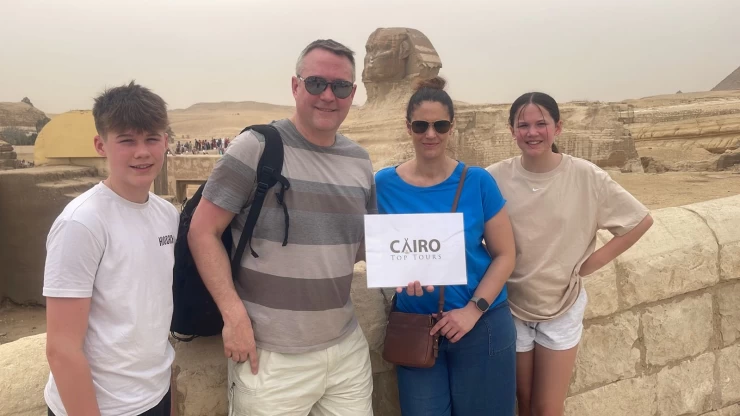
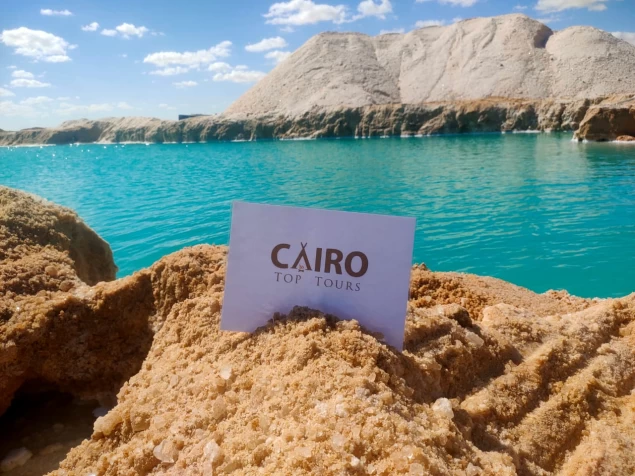
You Also May Like
Looking for something different? check out our related tour now, or simply contact us to tailor made your Egypt tour
Tour of Cairo's Egyptian Museum and Giza Pyramids
Enjoy the Egyptian Museum, which contains the world's largest collection of artefacts from the Egyptian civilisation. Also on this day you will enjoy the largest, most famous and tallest Egyptian pyramids, which are considered one of the most prominent tourist attractions for Egypt, and one of the most important sources of national income in Egypt.
Full-Day Islamic and Coptic Cairo Tour and Egyptian Museum
Visit Coptic Egypt and Islamic Egypt as well as the Egyptian Museum to enjoy Egypt's fascinating history, where your guide will provide you with information about the most important information and legends with deep meaning to the pharaohs. Don't miss out on our special offers tailored just for you.
Full-Day Tour to Giza Pyramids, Memphis, and Sakkara
Enjoy a tour with Cairo Top Tours to the pyramids, Saqqara, and Memphis. Explore the pyramids that reflect the evolution of Egyptian civilization. Built over a long period of time, the pyramids in ancient Egypt show an evolution in the architectural styles and engineering techniques used in construction.
Egypt Cairo Transit Tours
Enjoy a tour from Cairo airport with us. The area of the Giza Pyramids is one of the most famous monuments of Pharaonic Egypt, consisting of 3 pyramids "Cheops, Khafre, and Menkaure", where the first is considered one of the Seven Wonders of the World, and a few steps to the East, there are 3 small piles of stones (20 meters high) representing the pyramids of the Queens.
Reviews of the Middle East and Egypt Vacations
The kind of tours that budget travelers dream of-Many have acknowledged this fact on our social media pages, Trip Advisor, and You Tube videos. They do have professionals who show and explain everything for every location they tour in Egypt and the Holy Land.
Customer feedback samples that were destining to Egypt Tours include low-cost tours of Egypt featuring patently well-versed tour guides to put them through the history of every destination. They are displayed and reflected on Trip Advisors, YouTube videos, and our social media profiles.
The highly recommended travel experiences of exploring the iconic Giza Pyramids and delving into the historic wonders of the Saqqara Necropolis. These two incredible sites offer a glimpse into the ancient mysteries and architectural marvels that have defined Egypt's rich history and cultural heritage.
Photography policies at historical sites in Cairo can vary depending on the specific location and the rules set by the site management. However, there are some general guidelines and considerations to keep in mind when taking photographs at historical sites in Cairo:
Entrance Fees: Some historical sites charge an additional fee for photography. Make sure to inquire about any photography fees at the ticket counter when purchasing your entrance ticket.
Restrictions on Flash Photography: Flash photography is often prohibited in many indoor areas of historical sites, such as museums, temples, and tombs. Flash can be damaging to delicate artifacts and paintings. Always follow posted signs and instructions from site staff.
Tripods and Professional Equipment: The use of tripods and professional photography equipment, such as large cameras and drones, may be restricted or require special permits at some historical sites. Check in advance to avoid any issues.
Respectful Photography: Be respectful of the site and other visitors. Avoid blocking pathways or interfering with the experiences of other tourists. Don't touch or lean on ancient structures or artifacts.
Guided Tours: When taking guided tours, your guide can provide information on where photography is permitted and any specific rules that apply at each site.
Security Considerations: Some sensitive areas, including military installations and government buildings, may be off-limits to photography for security reasons. Always respect security personnel's instructions.
Commercial Photography: If you intend to use your photographs for commercial purposes, such as in a travel blog, for sale, or in publications, you may need to obtain special permits or permissions. Check with the relevant authorities.
Cultural Sensitivity: Be mindful of local customs and cultural sensitivities. On some religious sites, it may be inappropriate to take photographs. Always follow any posted guidelines and signs regarding photography.
Time Restrictions: Some historical sites may have specific hours during which photography is allowed, and it may be restricted during certain times of the day or during events.
Private Properties: If you plan to visit historical sites on private properties, such as palaces or estates, photography policies may vary, and you may need permission to take photographs.
Avoiding common travel scams requires vigilance, awareness, and some basic precautions. Scammers often target tourists because they may be unfamiliar with the local environment and customs. Here are tips to help you avoid falling victim to travel scams:
Research Your Destination: Before you travel, research your destination, including common scams reported by other travelers. Knowledge is your best defense.
Stay Alert: Be aware of your surroundings and trust your instincts. If something feels off or too good to be true, it probably is.
Protect Your Belongings: Keep your belongings secure at all times. Use anti-theft bags or wallets, and don't leave valuables unattended in public places.
Beware of Distractions: Scammers often work in pairs or groups. One person may distract you while another steals your belongings. Be wary of overly friendly strangers or sudden disturbances.
Use ATMs Wisely: Use ATMs inside banks or reputable establishments, and be cautious of card skimming devices. Cover the keypad when entering your PIN.
Check Bills and Change: Count your change and inspect bills when making purchases or receiving change to ensure they are not counterfeit or inaccurate.
Research Accommodations: Book accommodations through reputable websites or directly with hotels. Be cautious when booking through unknown or unofficial channels.
Be Skeptical of "Closed" Attractions: If someone tells you that a popular tourist attraction is closed, it might be a ploy to redirect you to a different, overpriced attraction. Verify such information independently.
Negotiate Prices in Advance: When using services like taxis, rickshaws, or street vendors, negotiate prices in advance to avoid surprises and disagreements.
Be Cautious with Guides: If you hire a local guide, make sure they are licensed and reputable. Don't be pressured into hiring a guide on the spot.
Check Official Identification: If someone claims to be a police officer or other official, ask to see their identification. In some countries, scammers impersonate law enforcement.
Ignore Unsolicited Emails and Calls: Don't respond to unsolicited emails, calls, or messages offering prizes, discounts, or lottery winnings. These are often phishing scams.
Use Caution with Wi-Fi: Be careful when using public Wi-Fi networks, as they may not be secure. Avoid accessing sensitive information or making online transactions on unsecured networks.
Purchase Travel Insurance: Travel insurance can provide protection against various travel-related risks, including trip cancellations, medical emergencies, and lost belongings.
Keep Emergency Contacts Handy: Have the contact information for your country's embassy or consulate readily available in case you need assistance while abroad.
Report Suspected Scams: If you encounter a potential scam or fraudulent activity, report it to local authorities or your embassy/consulate and share your experience with fellow travelers online.
Cairo and Giza are home to a wealth of archaeological sites that provide a window into Egypt's rich history and ancient civilization. Here are some of the most prominent archaeological sites in Cairo and Giza:
Giza:
Giza Pyramids: The Giza Plateau is home to three famous pyramids: the Great Pyramid of Khufu (Cheops), the Pyramid of Khafre (Chephren), and the Pyramid of Menkaure. These are among the most iconic and well-preserved pyramids in Egypt.
The Great Sphinx of Giza: Adjacent to the pyramids is the Great Sphinx, a colossal limestone statue with the body of a lion and the head of a pharaoh, believed to represent Pharaoh Khafre.
Pyramid Complexes: In addition to the main pyramids, each pharaoh's tomb includes various temples, causeways, and smaller pyramids for family members. These are integral parts of the archaeological sites.
Solar Boat Museum: Located near the Great Pyramid, this museum houses a reconstructed solar boat that was buried with Pharaoh Khufu to carry him to the afterlife.
Giza Plateau Sound and Light Show: While not an archaeological site in itself, the sound and light show at the Giza Plateau offers a unique experience with a narrated history of the pyramids, accompanied by spectacular lighting effects.
Cairo:
Egyptian Museum: While not an archaeological site in the traditional sense, this museum houses an extensive collection of ancient Egyptian artifacts, including mummies, statues, jewelry, and treasures from King Tutankhamun's tomb.
Saladin Citadel: The historic Citadel of Saladin is home to several well-preserved mosques, palaces, and fortifications, providing insights into the architecture and history of the Islamic period.
Mosques and Madrasas: Cairo boasts numerous historic mosques and madrasas (Islamic schools), such as the Sultan Hassan Mosque and the Al-Azhar Mosque, which showcase stunning architecture and Islamic art.
Khan el-Khalili Market: While primarily a bustling market, Khan el-Khalili's winding streets and historic buildings offer a glimpse into the city's history.
Coptic Cairo: Also known as Old Cairo, this district is home to several ancient Coptic Christian churches, including the Hanging Church and the Church of St. Sergius and Bacchus. The Coptic Museum is also located in this area.
Islamic Cairo: This area is dotted with historic mosques, madrasas, and other Islamic architectural gems, such as the Ibn Tulun Mosque and the Al-Hakim Mosque.
Old Cairo Gates: Gates like Bab Zuweila and Bab al-Futuh are well-preserved relics from the medieval period and offer architectural and historical significance.
Babylon Fortress: Located in Coptic Cairo, the Babylon Fortress is an ancient Roman fortress with remnants of churches and ancient structures.
Egypt's standard electrical voltage is 220 volts at 50 hertz. Sockets are of the European (2-prong, 2-pin plug) variety. If you are traveling from the United States, Canada, or another country where the standard voltage is 110, you will need to pack a power adaptor. You will only need to pack an international travel adaptor plug if you are coming from a country where the standard voltage is 220/240.
Visiting working archaeological sites in Egypt is generally restricted to authorized personnel, archaeologists, researchers, and professionals directly involved in excavation and preservation work. However, tourists interested in archaeology and history can engage in educational programs or tours that offer insights into Egypt's ancient sites and archaeological practices without actively participating in digs.
- Educational Tours.
- archaeological field schools.
- Museum Workshops.
- visiting archaeological sites.
- Public lectures and events
The oldest stone pyramid and a notable building in Egyptian architectural history is the Step Pyramid of Djoser.
Mastabas: Old tombs adorned with elaborate ornamentation and carvings.
The Unas Pyramid is well-known for its pyramidal writings.
Exhibiting items from the Saqqara necropolis is the Imhotep Museum.


Cairo Top Tours Partners
Check out our partners
